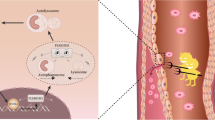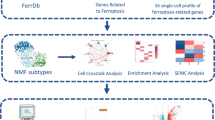Abstract
Objective
To investigate the effects of Xiezhuo Chubi Decoction (泄浊除痹方, XZCBD) on the microRNA expression patterns of kidney in mice with hyperuricemia.
Methods
Sixty Kunming male mice were randomly divided into the high-, medium-, and low-dose XZCBD groups, benzbromarone group, model group, and control group. Except the control group, all mice were established with yeast method combined with uricase inhibition method to build hyperuricemia model, and the corresponding drugs (37.5 g/kg, 18.75 g/kg, 9.375 g/kg, and 0.02 g/kg per day) were administrated on the 7th day. On the 22nd day, the blood uric acid concentration was detected, and microRNA with obvious changes in kidney was screened with qRT-PCR.
Results
The uric acid in the model group was higher than that in the control group, and the levels of the uric acid were reduced after being treated with XZCBD; the differences among groups were signifificant (P<0.05). Compared with the control group, 32 kinds of microRNA expression changes were detected on the 15th day after being treated with high-dose XZCBD by microRNA expression profifile screening. Among them, miR-34a could inhibit the expression of human urate anion exthanger 1, and miR-146a might have inhibited the inflflammatory reaction.
Conclusion
XZCBD could significantly reduce the serum uric acid level; its effect on hyperuricemia might be through affecting microRNA expressions.
Similar content being viewed by others
References
Wang F. Research progress for urate transporters in renal. Section Endocrinol Foreign Med Sci 2004;24:388–390.
Hong Q, Wu D, Chen XM, Hou K, Feng Z, Fu B, et al. Location and expression of human uric acid transporter in HKC. Chin J Nephrol (Chin) 2005;21:527–533.
Yan HY, Zhou LL. Research progress for effect of uric acid transport protein nuric acid transporter. China Pharmacy (Chin) 2007;18:1108–1110.
Cheong HI, Kang JH, Lee JH, Ha IS, Kim S, Komoda F, et al. Mutational analysis of idiopathic renal hypouricemia in Korea. Pediatr Nephrol 2005;20:886–890.
Sun WF, Zhang XX, Xu W. Therapeutic effect of two compositions of Xiezhuo Chubi Decoction on primary gout hyperuricemia. Milit Med J of South China (Chin) 2009;23:35.
Lewis BP, Burge CB, Bartel DP. Conserved seed pairing, often flanked by adenosines, indicates that thousands of human genes are microRNA targets. Cell 2005;120:15–20.
Wu LG, Fan JH, Belasco JG. MicroRNAs direct rapid deadenylation of mRNA. Proc Natl Acad Sci USA 2006;103:4034–4039.
Zhang B, Wang Q, Pan X. MicroRNAs and their regulatory roles in animals and plants. J Cell Physiol 2007;210:279–289.
Chen GL, Xu SY. Research progress for animal hyperuricemia model. Chin Pharmacol Bull (Chin) 2004;20:369–372.
Qin XC. Effects of iptakalim on hypertension and renal injury induced by hyperuricemia and its protective effects on the endothelial function. Beijing: PLA Postgraduate Medical School; 2006:14–18.
Sayed D, Rane S, Lypowy J, He M, Chen IY, Vashistha H, et al. MicroRNA-21 targets Sprouty2 and promotes cellular outgrowths. Mol Biol Cell 2008;19:3272–3282.
Thum T, Gross C, Fiedler J, Fischer T, Kissler S, Bussen M, et al. MicroRNA-21 contributes to myocardial disease by stimulating MAP kinase signalling in fibroblasts. Nature 2008;456:980–984.
Torcia MG, Santarlasci V, Cosmi L, Clemente A, Maggi L, Mangano VD, et al. Functional deficit of T regulatory cells in Fulani, an ethnic group with low susceptibility to Plasmodium falciparum malaria. Proc Natl Acad Sci USA 2008;105:646–651.
Tilton JC, Manion MM, Luskin MR, Johnson AJ, Patamawenu AA, Hallahan CW, et al. Human immunodeficiency virus viremia induces plasmacytoid dendritic cell activation in vivo and diminished alpha interferon production in vitro. J Virol 2008;82:3997–4006.
Tong GH, Zhang Y, Ma L. Research progress for hyperuricemia model of rodent animal. J Toxicol 2009; 23:159–162.
Chen GL, Xu XY. Research progress for animal hyperuricemia model. Chin Pharmacol Bull 2004;20:369–372.
Tang C, Yang K. A preliminary study on the Establishment of animal model with hyperuricemia. Tradi Chin Drug Res Clin Pharmacol (Chin) 2000;11:292–295.
Chen GL, Zhang QL, Ma XQ, Xu SY. Hyperuricemia model induced by yeast in mice. Chin Pharmacol Bull (Chin) 2003;19:467–469.
Yan HY, Ma Y, Liu M, Zhou LL. Effect of extracts of paederia scandens on mouse hyperuricemia induced by yeast and potassium oxonate. Acta Univ Med Anhui (Chin) 2007;42:676–678.
Tan WC, Tang JY, Zhang Y, Yang WX. The research of the function mechanism of anti-hyperuricuria through warming kidney and removing blood Stasis. Lishizhen Med Mat Med Res (Chin) 2006;17:11–13.
Gao BZ, Li YP, Li CD, Wu TY, Zheng LP. Effect of different TCM prescriptions on XOD & renal function in rats with hyperuricemia. China J Tradit Chin Med Pharm (Chin) 2008;23:97–99.
Hamada T, Ichida K, Hosoyamada M, Mizuta E, Yanagihara K, Sonoyama K, et al. Uricosuric action of losartan via the inhibition of urate transporter 1 (URAT 1) in hypertensive patients. Am J Hypertension 2008;21:1157–1162.
Author information
Authors and Affiliations
Corresponding author
Additional information
Supported by the National Natural Science Foundation of China (No. 81072915); Military Eleventh-Five-Year Tackle Key Program in Science and Technology (No. 2006062004)
Rights and permissions
About this article
Cite this article
Sun, Wf., Zhang, Xx., Sun, Fy. et al. MicroRNA expression patterns of the kidney in hyperuricemia mice treated with Xiezhuo Chubi Decoction (泄浊除痹方). Chin. J. Integr. Med. 17, 35–42 (2011). https://doi.org/10.1007/s11655-011-0605-6
Received:
Published:
Issue Date:
DOI: https://doi.org/10.1007/s11655-011-0605-6




